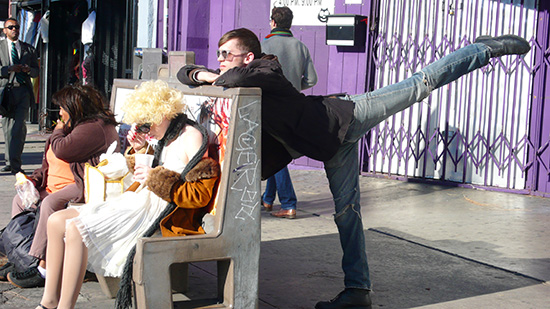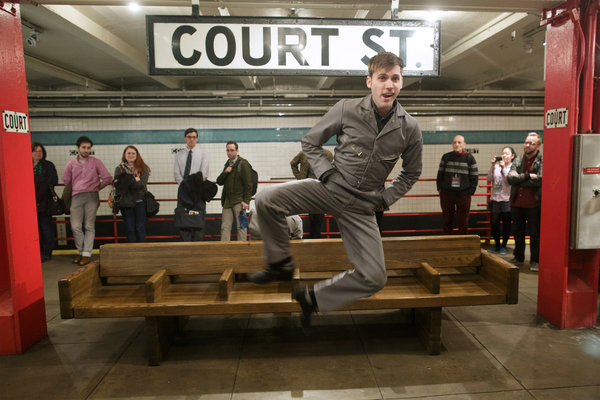Jamie Benson Attempts to Make Sense of Himself
As part of this month’s series on dancers who facilitate their own dance practice outside of a major institution, New York based Jamie Benson attempts to make sense of his dance practice, how he keeps the wheels turning, and the “why” that drives it all.
~~
How often and in what kind of situations do you perform?
Boy every day of this wild existence is so different, but I seem to have one or two performances/screenings a quarter on average. That being typed, I’ve had three separate performances within the same week before too. In the past, performances mainly occurred in black box theaters, but in recent years I’ve adjusted to performing site-specific work almost entirely (invading streets, piers, parks, museums, bathrooms, bars, etc.). Theater performances are a bit too removed from the guts of my work, which conjures situations and themes experienced in daily life. I’m also transitioning from doing more live work to more film work in order to access a larger online audience.
When and where do you rehearse?
I find myself using the space rental pimp that is SpaceFinder NYC often. In terms of time, I make some concessions based on who’s involved with each project and what their availability is. Evenings tend to be the best time for me to rehearsal. Chez Bushwick and Chrystie Street Ballet Academy tend to be recurring characters in the movie that is my life. Each performance is its own case-study though, each yielding varied results.
Do you take classes or do a personal practice?
Both. Finding a way to deal with this body is a near constant pre-occupation. Do I have a clear regiment? No. Do I wish I had one? Yes. Ultimately, I take some form of both Pilates and yoga two times per week (so four classes total). When I take dance class it’s usually ballet in an attempt to keep some semblance of my “lines” intact. This usually happens at the Mark Morris School or Brooklyn Ballet, but I’m kind of a dance class tourist so I like to mix it up. As a self-absorbed person functioning within a labyrinth-esque schedule, I also turn to YouTube videos to supplement my dance conditioning. A conditioning channel called Fitness-Blender certainly gets some action from me on a near weekly basis too.
How do you fund your work as an individual artist?
What are the benefits to working on your own (as opposed to working within a company or institution)? What are the drawbacks?
You are (terrifyingly) free when working outside of a company or institution. Nothing is diffused. You get all the credit and/or the blame for your creative convictions and how they’re executed.
Brand recognition is a double-edged sword. Working outside of an institution, your individual ideas are liberated from the possibility of being lumped under a more powerful brand identity. You’re less likely to be overly influenced by an iconic technique, like Graham or Cunningham, but you have less cache within the press and dance community. Being associated with an institution gives audiences an immediate understanding of what your identity may be. This is a pro and a con too though since others will most likely have formed opinions about the institution you’re affiliated with. Whether well-received or not, some of your success or failure may be written off as being another byproduct of something that is not uniquely you. In some (if not many) instances, they may be right. Ideally, a choreographer, if they have a unique enough voice, has an opportunity to use the institutions they’re linked with to launch themselves into a new stratosphere creatively.
When working on your own, you’re completely free from both scheduling and paying ridiculously busy, creative people. This also has its pros and cons. It can be tricky to clearly represent the source of whatever emotion one is exploring as a soloist and harder to suss out how it might “read” to an innocent audience-goer. There’s a more immediate response when working in a group. They laugh when it’s funny, look at you cross-eyed when it’s too complicated or awkward, and so on and so forth. As audience members, we’ve all experienced that performance where a soloist goes from poised dancer to insane person in seconds flat. As choreographers we think we know how something looks from the outside because we feel it so deeply. But as an audience member, one can become perplexed and feel alienated really fast if there’s no immediate access point, such as a topical reference, a common emotional gesture, something. Even if we deliberately create space for the audience to make their own choices about what we’re doing, our job is still ultimately to communicate something through movement. Peer review and I have become good friends to counter this issue.
Ultimately, I think most people who go at it alone don’t fit into the standard model of whatever industry is most in line with their compulsions. In a sense, I don’t really feel I have a choice in the matter. I’m compelled to choreograph, trained in ballet, hip hop, jazz and modern dance forms, but not wholly on board with the classic expression of any of those styles. Because of this, I enjoy subverting and perverting the industry. Add in my passion for raunchy stand-up and sketch comedy and you have an alternative performance universe that is not in phase with the one of this world. I live on an alternate plane of dance existence. Please, you reading this now. You are invited to visit me there. Hell, pull up a chair, stay for a while.
What do you find are the hardest obstacles to overcome in making your work?
As a one-man band, conjuring the time to create, fundraise and promote the work, while also invoking inspiration on demand, is exquisitely hard. I use the word “exquisitely” because the satisfaction gained when it all comes together is so much more profound than when acting as a small part of a greater successful thing. And even when you’re able to procure time to nurture your work, you may not strike gold creatively. People fail to understand fully that every aspect of an entrepreneurial pursuit, whether art or business-related, requires imagination, energy and inspiration in order to break away from the clichés of one’s industry. These are fickle and finite abilities. Writing a compelling press release or grant proposal requires just as much imagination as plotting out an entire dance. Just because you managed to squirrel away two hours for each task within one day (yay you), doesn’t mean your connection to the muses is going to stay fresh for that long. In fact, those muses will mostly get sick of dealing with your nagging ass.
An obstacle I’ve recently overcome is getting influenced by the massive amount of proposal deadlines one must attack in order to unearth a full season of dance, alone. The glorious thing is that there are a plethora of application options for everything from fellowships, residencies, grants, performance opportunities and even more. In order to be competitive within a drop dead gorgeous pool of artists, one must align their experience and goals with that of each specific opportunity. You’ll want to give yourself as many chances as possible to produce, or tour new work and, in doing so, may suggest ideas that you wouldn’t necessarily create on your own. Maybe I wouldn’t have come up with this performance idea that heals veterans or at-risk children if I didn’t have this certain application deadline coming up that asks for it, ya know? Your proposals want to be cohesive with what you’re applying for, of course, but don’t let it veer you off course from the kind of work you’d prefer to do. I have only recently drawn a definitive boundary with regards to this hazard, but it has absolutely been an obstacle. Be more shrewd people (points at own face). When working within institutions, one has a built-in network which can offer a consistent thread of opportunities. This sounds wonderful. I know people that, because they were part of established companies or institutions, don’t even have to really apply for opportunities. That is a remarkable benefit of working in a pre-existing system. That being typed, forging new creative ground can require a lot more proposal writing.
How do you personally measure success? When do you feel most successful?
My ideas around success are morphing and mutating even as I type this. Artists are often paid in prestige, earning greater opportunities to prove themselves in an ever increasing series of tests. This includes building relationships with esteemed schools, festivals, funders, performance venues, galleries, press contacts, etc. Much, if not most, of these relationships are somewhat one-sided. You pay (through the nose) for the schools you attend. OK, that’s common across professions, but fine art forms are steeped in academia. Because of this, the academic model appears to continue for us indefinitely. Meaning, we kill ourselves to innovate content, manifest funding, complete involved proposals, audition work, and build our own audience, only to battle it out with other artists for spots in a limited set of dance events. Many of these events pay very little, or nothing at all, for the work we’ve destroyed ourselves to make. There is an irrational notion that exposure and experience is enough to warrant creating new work. I’ve found that these free, or near free, performances seem to perpetuate to the point of the artist always investing more than they get back. Those festivals, venues and galleries need our work AND our audiences in order to exist but we all accept the current model because we have, in perhaps an unconscious way, agreed that we don’t expect to make a living with our art. Being able to flesh out my CV with reputation-enhancing bullet points used to make me feel successful but that has changed, for good.
Is money all there is? Of course not. I wouldn’t have made most of my life choices if it was enough alone. But, I think many of us make too many concessions in order to pursue the creative goals we have. Ultimately, we want to be recognized for our talent, skill and insight into the mysteries of life. This can come in the form of feedback from our mentors, peers, the press and our audience. That was enough for a while, but now this painstaking work must be matched with some kind of earthly compensation, whether it comes in trade, with in-kind donations, or from commissions. I now need to be able to flourish, both creatively and practically, from the results of my creative work to feel successful.
I’ve recently been thinking about Aristotle’s Virtue Ethics and the question of what makes a good life? As opposed to Deontology or Consequentialism, Aristotle makes the claim that pursuing your individual happiness, by developing personal virtues, is more beneficial to the whole of humanity than relying on societal servitude to define what is moral, or what’s good. I think artists have an innate understanding of this, choosing to pursue our most inner desires versus what our parents or teachers tell us is the proper way to be a productive member of society. But that inclination is often unfinished. Virtue Ethics requires that you establish your own “mean,” or middle ground, with regard to certain virtues, like honesty or fearlessness. I think artists often fail with regard to the notion of generosity, being too generous to the point of giving their work away. This is an unbalanced approach to virtue and, in Aristotle’s terms, decreases the probability of one having a flourishing life. I believe a flourishing life as an artist is one in where you creatively express your most authentic self (however niche it is) in as clear a way as possible, on as many platforms as necessary to find and nurture an audience that resonates with you. To continually receive satisfaction, both emotionally and tangibly, I think remaining a little dissatisfied, ambitious and scared helps to prompt a success response. Overcoming the new art and lifestyle challenges you set for yourself feels like success.
~~
Jamie Benson is a dancer, choreographer and alumnus of Cornish College. He has danced in LATC’s Shag with a Twist, the film Rent, McDonald’s Mario commercial, TV show Dance360 and Rudy Perez’ Ensemble. Jamie’s choreographic work has been presented at the Luckman Complex, Highways, Bootleg Theater, NY Transit Museum, Triskelion and Dixon Place, featured in the NY and LA Times, Phaidon Press’ Wild Art, and awarded a grant from the Brooklyn Arts Council. His films are official selections of the Cinedans Film Festival, Athens Video Dance Project, Video Danza Havana, and Bucharest Dance Film Festival. Learn more at jamiebenson.com.




One Response to “Jamie Benson Attempts to Make Sense of Himself”
Excellent information Jamie! Great presentation!
Comments are closed.